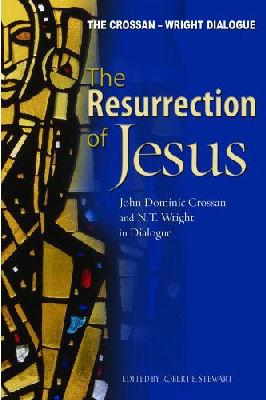
|
Posted August 11, 2006
Book: The Resurrection of Jesus: John Dominic Crossan and N.T. Wright in Dialogue Editor: Robert B. Stewart Fortress Press, Minneapolis. 2006. Pp. 220 An Excerpt from the Jacket:
Two of today’s most important and popular New Testament scholars — John Dominic Crossan and N.T. Wright — here air their very different understandings of the historical reality and theological meaning of Jesus’ resurrection. This lively and informative book highlights points of agreement and disagreement between them in a long-overdue conversation and, with the help of significant scholars from a variety of disciplines, explores the many attendant issues. Along with Crossan, Wright and editor Robert B. Steward, contributors include: William Lane Craig, Craig Evans, R. Douglas Geivett, Gary Habermas, Ted Peters, Charles Quarles and Alan Segal. An Excerpt from the Book: Early Christian belief in resurrection is clearly not something derived from any form of paganism; it is a mutation from within Judaism, or rather six mutations. First, belief in the resurrection has moved from being a peripheral item of belief, as it is in Judaism, to the center. Second, the meaning of resurrection has been sharpened up. Jewish sources leave it vague as to what form the new body will take,, but the early Christian sources, again and again, indicate that the body will be transformed into a new type of immortal physicality. Third, there is no spectrum of belief in early Christianity on what happens after death, as there is both Judaism and paganism; there were many different opinions out there. But from Paul through to Tertullian, there is development and reflection about what precisely resurrection would mean, and how to argue it before a skeptical audience. But they all, except the Gnostics and the simi-Gnostics, believe in resurrection. No Christians known to us retain signs of the other main beliefs of the period. Fourth, resurrection as an event has split into two. Those first-century Jews who expected the resurrection saw it as a single event, the raising to new bodily life of all at the very end. But it is central to Paul and, after him, to all other early Christian writers that the resurrection is now a two-stage event — or better, a single event taking place in two moments, as Paul puts it: Christ the first fruits, and then at his coming, those who belong to Him. Fifth, resurrection functions in a newly metaphorical way. Resurrection, the word or concept, could be used in Judaism, as in Ezekiel 37, as a metaphor for the return from exile. That has disappeared in early Christianity. Instead, we find the term resurrection, still possessing its literal, bodily meaning, also functioning metaphorically, as in Romans 6 or Colossians 2 and 3 with reference to baptism and holiness. Sixth, nobody expected the Messiah to be raised from the dead, for the simple reason that nobody in Judaism at the time expected a Messiah who would die, especially one who would die shamefully and violently. But not only did the early Christians believe that the Messiah had been raised from the dead, they made the resurrection a key element in their demonstration that he was the Messiah, developing several brand-new exegetical arguments to make the point, particularly from the Psalms and Isaiah, as in Romans 1, Romans 15, Acts 2 and so forth. Table of Contents: 1. The resurrection: historical event or theological explanation? A dialogue 2. In appreciation of the dominical and Thomistic traditions: The contributions of J.D. Crossan and N.T. Wright to Jesus research 3. The hermeneutics of resurrection: How N.T. Wright and John Dominic Crossan read the resurrection narratives 4. Mapping the recent trend toward the bodily resurrection appearances of Jesus in light of other prominent critical positions. 5. The epistemology of resurrection belief 6. The Gospel of Peter: Does it contain a precanonical resurrection narrative? 7. The resurrection: faith and history? 8. Wright and Crossan on the historicity of the resurrection of Jesus 9. The future of the resurrection |
|
